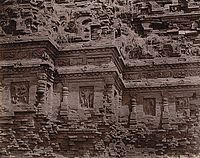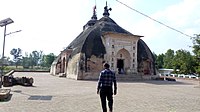
Indian architecture is rooted in the history, culture, and religion of India. Among several architectural styles and traditions, the best-known include the many varieties of Hindu temple architecture and Indo-Islamic architecture, especially Rajput architecture, Mughal architecture, South Indian architecture, and Indo-Saracenic architecture. Early Indian architecture was made from wood, which did not survive due to rotting and instability in the structures. Instead, the earliest existing architecture are made with Indian rock-cut architecture, including many Buddhist, Hindu, and Jain temples.
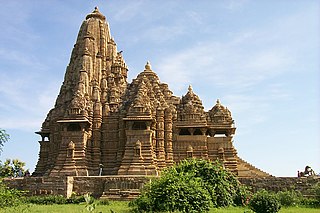
Hindu temple architecture as the main form of Hindu architecture has many varieties of style, though the basic nature of the Hindu temple remains the same, with the essential feature an inner sanctum, the garbha griha or womb-chamber, where the primary Murti or the image of a deity is housed in a simple bare cell. For rituals and prayers, this chamber frequently has an open space that can be moved in a clockwise direction. There are frequently additional buildings and structures in the vicinity of this chamber, with the largest ones covering several acres. On the exterior, the garbhagriha is crowned by a tower-like shikhara, also called the vimana in the south. The shrine building often includes an circumambulatory passage for parikrama, a mandapa congregation hall, and sometimes an antarala antechamber and porch between garbhagriha and mandapa. In addition to other small temples in the compound, there may be additional mandapas or buildings that are either connected or separate from the larger temples.

Harihara is the dual representation of the Hindu deities Vishnu (Hari) and Shiva (Hara). Harihara is also known as Shankaranarayana.
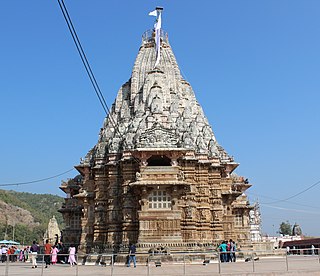
Shamlaji, also spelled Shamalaji, is a major Hindu pilgrimage centre in Aravalli district of Gujarat state of India. The Shamlaji temple is dedicated to Vishnu. Several other Hindu temples are located nearby.

Aihole (ಐಹೊಳೆ), also referred to as Aivalli, Ahivolal or Aryapura, is a historic site of ancient and medieval era Buddhist, Hindu and Jain monuments in Karnataka, India that dates from the sixth century through the twelfth century CE. Most of the surviving monuments at the site date from the 7th to 10th centuries. Located around an eponymous small village surrounded by farmlands and sandstone hills, Aihole is a major archaeological site, featuring over 120 stone and cave temples spread along the Malaprabha river valley, in Bagalakote district.

The Udayagiri Caves are twenty rock-cut caves near Vidisha, Madhya Pradesh primarily denoted to the Hindu gods Vishnu and Shiva from the early years of the 3rd century CE to 5th century CE. They contain some of the oldest surviving Hindu temples and iconography in India. They are the only site that can be verifiably associated with a Gupta period monarch from its inscriptions. One of India's most important archaeological sites, the Udayagiri hills and its caves are protected monuments managed by the Archaeological Survey of India.

Sculpture in the Indian subcontinent, partly because of the climate of the Indian subcontinent makes the long-term survival of organic materials difficult, essentially consists of sculpture of stone, metal or terracotta. It is clear there was a great deal of painting, and sculpture in wood and ivory, during these periods, but there are only a few survivals. The main Indian religions had all, after hesitant starts, developed the use of religious sculpture by around the start of the Common Era, and the use of stone was becoming increasingly widespread.

The Ranganathaswamy temple or Sri Ranganathaswamy temple in Srirangapatna, in the Mandya district of Karnataka state, India, is dedicated to the Hindu god Ranganatha. The temple is Classified one among the 108 Abhimana Kshethram of Vaishnavate tradition. It is one of the five important pilgrimage sites of Sri Vaishnavism along the river Kaveri for devotees of Ranganatha. These five sites are collectively known as Pancharanga Kshetrams in South India. Since Srirangapatna is the first temple starting from upstream, the deity is known as Adi Ranga. The town of Srirangapatna, which derives its name from the temple, is located on an island in the river Kaveri.

The Dashavatara Temple is an early 6th century Hindu temple located at Deogarh, Uttar Pradesh which is 125 kilometers from Jhansi, in the Betwa River valley in northern-central India. It has a simple, one cell square plan and is one of the earliest Hindu stone temples still surviving today. Built in the Gupta Period, the Dashavatara Temple at Deogarh shows the ornate Gupta style architecture.
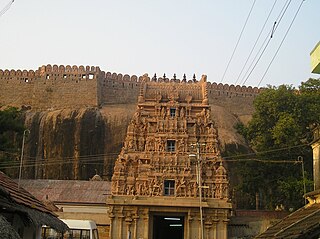
Sathyamurthi Perumal Temple in Thirumayam, a panchayat town in the South Indian state of Tamil Nadu, is dedicated to the Hindu god Vishnu. Constructed in the Dravidian style of architecture, the temple is glorified in the Nalayira Divya Prabandham, the early medieval Tamil canon of the Alvar saints from the 6th–9th centuries CE. It is one of the 108 Divya Desams dedicated to Vishnu, who is worshipped as Sathyamurthi Perumal and his consort Lakshmi as Ujeevana Thayar.
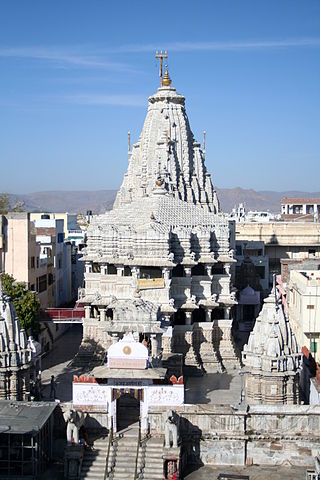
Jagdish Temple is a large Hindu temple in the middle of Udaipur in Rajasthan, just outside the royal palace. It has been in continuous worship since 1651. A big tourist attraction, the temple was originally called the temple of Jagannath Rai but is now called Jagdish-ji. It is a major monument in Udaipur.

Sasbahu Temple, also called the Sas-Bahu Mandir, Sas-Bahu Temples, Sahasrabahu Temple or Harisadanam temple, is an 11th-century twin temple in Gwalior, Madhya Pradesh, India. Near the Gwalior Fort and dedicated to Vishnu in his Padmanabha form, like most Hindu and Jain temples in this region, it is mostly in ruins and was badly damaged from numerous invasions and Hindu-Muslim wars in the region. It was built in 1093 by King Mahipala of the Kachchhapaghata dynasty, according to an inscription found in the larger of the twin temple. The twin temples are situated in the Gwalior Fort.
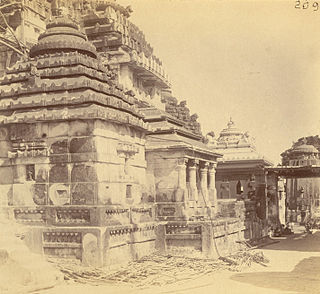
The Vimala Temple or Bimala Temple is a Hindu temple dedicated to goddess Vimala or Bimala (ବିମଳା), located within the Jagannath Temple complex in Puri in the Indian state of Odisha. It is generally regarded as a Shakti Pitha, among the holiest temples dedicated to the Hindu Goddess.
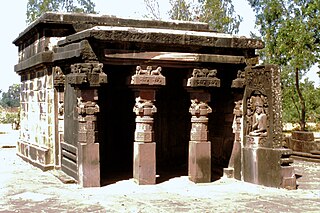
Tigawa is a village in Indian state of Madhya Pradesh and an archaeological site with a complex of about 36 Hindu temple ruins. Of these, the small but important and ancient Kankali Devi Temple is in good condition, and is usually dated to about 400-425 CE. Unless another building is mentioned, references to "the temple" below refer to this.
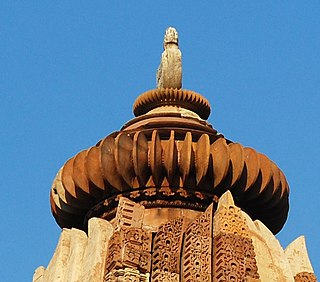
An amalaka, is a segmented or notched stone disk, usually with ridges on the rim, that sits on the top of a Hindu temple's shikhara or main tower. According to one interpretation, the amalaka represents a lotus, and thus the symbolic seat for the deity below. Another interpretation is that it symbolizes the sun, and is thus the gateway to the heavenly world.
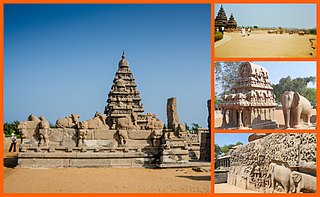
The Group of Monuments at Mahabalipuram is a collection of 7th- and 8th-century CE religious monuments in the coastal resort town of Mahabalipuram, Tamil Nadu, India and is a UNESCO World Heritage Site. It is on the Coromandel Coast of the Bay of Bengal, about 60 kilometres (37 mi) south of Chennai.
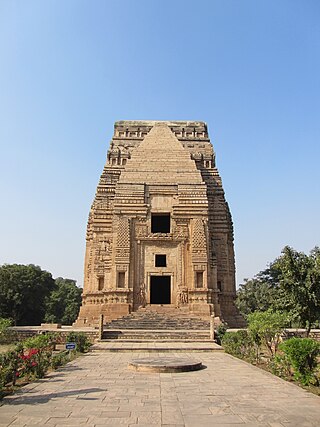
Teli ka Mandir, also known as Telika Temple, is a Hindu temple located within the Gwalior Fort in Madhya Pradesh, India. Dedicated to Shiva, Vishnu and Matrikas, it has been variously dated between the early 8th and early 9th century CE.

The Art of Mathura refers to a particular school of Indian art, almost entirely surviving in the form of sculpture, starting in the 2nd century BCE, which centered on the city of Mathura, in central northern India, during a period in which Buddhism, Jainism together with Hinduism flourished in India. Mathura "was the first artistic center to produce devotional icons for all the three faiths", and the pre-eminent center of religious artistic expression in India at least until the Gupta period, and was influential throughout the sub-continent.

Ancient Indian architecture ranges from the Indian Bronze Age to around 800 CE. By this endpoint Buddhism in India had greatly declined, and Hinduism was predominant, and religious and secular building styles had taken on forms, with great regional variation, which they largely retain even after some forceful changes brought about by the arrival of first Islam, and then Europeans.

Gupta art is the art of the Gupta Empire, which ruled most of northern India, with its peak between about 300 and 480 CE, surviving in much reduced form until c. 550. The Gupta period is generally regarded as a classic peak and golden age of North Indian art for all the major religious groups. Gupta art is characterized by its "Classical decorum", in contrast to the subsequent Indian medieval art, which "subordinated the figure to the larger religious purpose".








